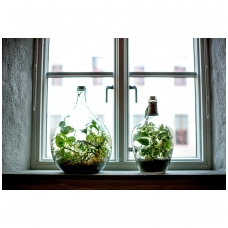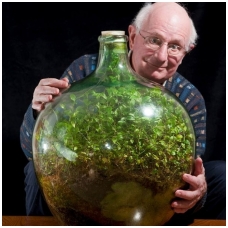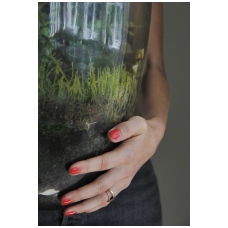Ecosystem in a bottle

While winter is not preparing to leave, our eyes are longing for something green, lush, bushy, branched, leafy, bursting with buds and spreading greenery. This nostalgia prompted us to write about a very nice thing - green ecosystems in bottles. Indeed, not only bottles, any transparent container will fit our needs.
Perhaps the oldest known ecosystem in the world belongs David Latimer of the United Kingdom. His ecosystem in the bottle is 60 years old!
What does it take to make such an ecosystem?
You will need a nice glass jar with a stopper. Why beautiful and why glass? Of course, plastic would work well too, but if your ecosystem experiment succeeds, it will decorate your home for many more years, so it wouldn't be plastic that over the years loses transparency and doesn't look nice (unless it looks!).
You will still need drainage pellets or pebbles: if you sometimes add a little too much water, the drainage layer will help to prevent the plant from rotting. We recommend the use of any type of burnt clay drainage rather than pebble as its honeycombed surface has excellent moisture absorption and slow release to plants.
You will also need soil- choose it based on what is natural to the plants which you aregoing to grow.
Finally, you will need seedlings, seeds or mature plants of your choice - depending on what your small - world creation plan is. You may want a composition of decorative-looking branches or pebbles - in which case you will need them as well.
If the neck of the bottle is narrow or the container itself is tall and narrow, you will also need a wire and a cut plastic bottle / carton tube to plant the plant or place seeds to the ground. using Chinese chopsticks and disposable spoons, you can make long mini shovels. Just stick them with an adhesive tape.
Before planting it is advisable to disinfect the container by washing it with green soap.
How is that possible at all?
When we seal the bottle, we create a completely self-sustaining ecosystem where plants can survive through photosynthesis. The bottle contains everything the plant needs. The only externally used resource that is necessary for such ecosystems is sunlight, which allows plants to survive and reproduce through photosynthesis.
The water which is being added when planting the ecosystem is just enought for those plants forever. The roots of the plant soak up the water, then the moisture is evaporated through the leaves of the plant and condenses into droplets on the walls of the vessel, whereupon they return to the soil and the process begins again. Dying plants or plant leaves compost and turn into fertilizer for the living.
What plants can be planted?
These ecosystems can grow a wide variety of plants, but just take into account the size of the adult plant - it must not exceed the size of the capacity. We recommend growing evergreen herbaceous plants. The common grass looks really nice and fills the tank perfectly.
If you want to plant more than one species of vegetation in the same jar, these should be plants that enjoy the same conditions, since you will only water once, before you plug the glass container. You also have to accept that after planting more than one species, you will most likely end up with only one. If you decide to grow succulents, be very careful - not all succulents have the same water requirement - gather all the necessary information about the compatibility of your future neighbors before planting. Watering succulents requires very little water. When planting other plants - add water as much as you would when watering this plant in a pot.
Photo Sources:
www.reclaimgrowsustain.com; www.bhg.com; www.gp.se; www.elledecoration.se; www.pexel.com






